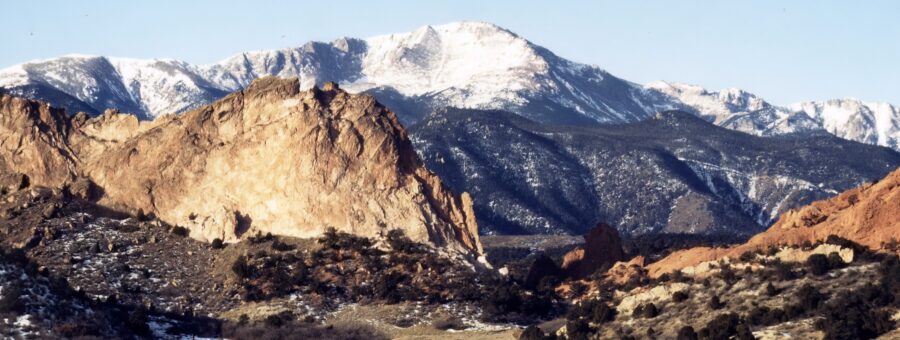My Total Obsession and Perseverance with Mountaineering

Shôn Ellerton, Feb 16, 2024
Ever since I was a teenager, I had this crazy obsession with climbing mountains but I look back at the power of perseverance, obsession, and failure.
A couple of years ago, I went to visit family and friends in Seattle. It was a clear and deep blue sky and as I was sitting on the plane making that final descent to the airport, I looked out of the window and saw the majestic awe of Mount Rainier, pristine-white with snow seeming to puncture into the stratosphere, although that would require an additional 5,000 metres in height added to its already impressive 4,392 metres. But we’re starting at sea level, so it looked absolutely enormous against the surrounding mountains, all of which looked like mere hills in comparison. It was a crisp but cold December day, so one can imagine what the conditions would have been like at the top.
I felt like I wanted nothing more than to get some kit, and hike to the top of it. But alas, it wouldn’t be that simple. This sort of adventure needs a bit of planning and preparation, and, most of all, time and perseverance.
It brought memories of my mid to late teenage years back in Colorado. My utter and absolute obsession with mountaineering and climbing in general. It’s funny how much such an obsession can take over one’s daily life. Looking back in hindsight, I’m glad that I did have this obsession; however, it played havoc with my school grades. To compound on this, I was also obsessed with programming BASIC and began to explore the world of databases. I was one of those people who liked to create lists of everything.
I was an ‘A’ student but these two obsessions, mountaineering and computing, made anything taught to me at school exceedingly dull and boring. Trigonometry, economics, chemistry, and calculus were subjects from Hell and I did the absolute minimum required to pass them. Actually, I tell a lie. On one semester, I failed chemistry completely and received a big fat ‘F’, but only after nearing destroying the lab with an unauthorised concoction of chemicals which shouldn’t be mixed together. Unfortunately, it brought my overall grades towards a ‘C’.
I had other hobbies like piano, judo and archery, which I enjoyed, although I didn’t take archery seriously enough and thought it would be amusing to run around the neighbourhood shooting broadheads with a compound bow into the door panels of parked cars along the street and clouting arrows haphazardly, many of which made a satisfying sound striking the timber roofing of some random house down the street. These activities didn’t interfere with my grades. They could be done at a whim’s notice and sessions were around an hour or two at best. But mountaineering? It prayed on my mind constantly. Most of my friends had girls on the brain, but hey. Mountains can’t talk back and break hearts, but they do need the utmost respect because they can break limbs!
I was not your typical teenager.
I was fortunate to be raised in places which boasted plenty of mountains to climb on. Colorado and Wales. The Welsh mountains are far easier, being not so high, and not so remote to get to. Being ancient and worn down, all the mountains in Wales are easy to get to the top. Even the more challenging routes are not much more than a rock scramble. However, in Colorado, there are a few mountains which have proved to be quite a challenge, whether it is due to technical difficulty or remoteness. Just getting to the base of some of these mountains often warrants an entire expedition. Of course, this is all chicken-feed when compared to big-mountain climbing in the Himalayas or climbing remote volcanos in the frozen wastelands of Antarctica. But for me at the time, a teenager who just learned how to drive a car, I was spending as many weekends as possible driving to trailheads of Colorado’s most memorable peaks, attempting to get to the top, and usually alone and during any season of the year including winter.
I lived in Colorado Springs, which sits in the shadow of one of Colorado’s most iconic mountains, Pikes Peak, as shown in the header photo of this article. Not a difficult mountain to climb, although the long 13-mile Barr Trail, which has the most vertical elevation gain of any other trail in the United States at around 8,000 feet, can be a bit of a slog, especially the last three miles where the altitude kicks in. And I was not really the most physically fit of kids in my age group. But I was determined. Pikes Peak is one of Colorado’s 54 ‘fourteeners’; those peaks which exceed 14,000 feet in elevation. Being so close to home, I climbed this quite a few times at different times of the year.
But I was bitten by the bug, so to speak. I wanted to climb the other 53, but that was simply not going to happen because of the distances involved to drive to them. Also, at the tender age of being a teenager, I didn’t have the resources nor the time to do this. But I certainly made a valiant effort all the same. After all, I passed my driving licence and had use of a Volkswagen Rabbit which gave me a new degree of freedom. However, not too far away, about 80 miles or so, lies the beautiful and scenic Sangre de Cristo range (translated as the Blood of Christ) which boasts some of Colorado’s more challenging of the ‘fourteeners’. Blanca Peak, Crestone Peak, and the iconic Crestone Needle, which requires some reasonable degree of rock scrambling skills on highly exposed spots. Being not particularly fearful of heights, much to my mum’s chagrin, I find traversing, or scrambling across narrow very exposed ridges between peaks, exceptionally exhilarating. There is this linear progression of oneself balancing precariously on top of a ridge against howling winds knowing that there would be a most certain death should one fall off either side into the great cirques below, some of which cradle mysterious, cold and deep lakes. That feeling of being so utterly small within Nature’s vast creation is humbling to say the least. There is nothing quite like it. Being on the knife-edge of death, a place most fully grown men start shaking uncontrollably for fear of falling. I often practiced my skills and enjoyed this euphoric feeling by climbing to the top of the giant red rocky spines of the Garden of the Gods in my hometown of Colorado Springs as shown in the header photograph of this article.
Naturally, the Crestones were a magnet to me, being not only visually stunning and reasonably challenging, but being less than two hour’s drive away. Unfortunately, the trailhead which starts at Colony Lakes, at the base of the peak, sits around 20 miles away on a very rough 4WD track from the parking area in Wet Valley. I attempted this quite a few times, usually in snowy conditions on rented snowshoes as most of my hiking was out-of-season because I was usually overseas during the summer months. And usually alone, which, looking back, is not a good idea, although it did test my fortitude and resilience knowing that every step forward would require going back the same way. And you were on your own with nothing to save you should anything happened. When that sun goes down and the bright blue-steel stars come out, and then one hears the distant wolves howling, it suddenly dawns upon you how exposed you are. And oh! The frigid coldness! During out-of-season months, I have never encountered another soul in the entire area, and the remoteness is daunting, but at the same time, edifying. When I’m back at home, I often want to return straight back into the lonely wilderness again. A place no ordinary mortals feel comfortable in venturing into.
I kept failing but I was damned determined. In snow, I was getting exhausted using the snowshoes and eventually turned back. Or I got too cold and realised that I was not going to make camp at Colony Lakes safely. Or simply, I had a strange feeling of loneliness and dread and lost the will at the time to continue. Although I was foolhardy to carry out this alone, I did have a sense of instinct whether to carry on or not knowing that karma would get the better of me if I didn’t. I spent a lot of time in my outdoor pursuits observing lightning strikes during summer afternoons, or what happens when a blizzard comes in. I knew where to go and how to stand in an electrical storm. I’ve seen blistering multiple repeated strikes of lightning hitting the same pointy spot on a ridgeline. The power of nature can never be underrated. I also knew when I was about to exceed the boundaries of my human limits. Although I was determined, I knew it was better to fail than take a crazy risk. I can always return and make another attempt. By the way, statistically, there is a far greater chance of perishing in remote areas than say, far more technically challenging popular mountains like the Matterhorn in Switzerland, which is a magnet to thousands and thousands of climbers each year.
All this was done without my mother knowing about it, of course. I made up some crazy-ass story that I was camping out with friends or something more benign and safe that had a nearby telephone to hand if something happened. It’s quite strange looking at some of my photos as a 16-year-old teenager and to think that I was in this heightened plane of obsessive thought and adventure. In recent years, my wife and I have hosted many international student teenagers from other countries and found most of them with absolutely little or no sense of adventure. I could not envisage any one of them possessing the essential toolkit to undertake a several-hour hike let alone a mountaineering expedition.
My mountaineering obsession continued throughout the week as well. As soon as I finished school, I would go to the public library and check out books with anything to do about climbing the mountains of Colorado. I would also check out publications by the Sierra Club on survival skills including how to build snow drift caves, what clothes to wear, what food to bring, what camp stoves to get, and of course, learning not to do stupid things like building a bonfire under a tree laden with snow. There was also a lot of stuff on rope-work, crampons, carabineers and other hard-core climbing paraphernalia, but that was to come later during my late twenties, in which I embarked in the crazy world of rock climbing. But then, it was just making sure what kit I needed to survive, especially in winter conditions.
But that obsession didn’t end there either.
When I got home, my geeky predilection to making neat lists of everything extended into the realm of mountaineering. I would take out an electronic typewriter (remember, this was the 80s), and type up exhaustive lists of mountains in Colorado and categorised them in terms of technical difficulty and accessibility. Being a keen skier since I was around nine or so, I graded them with the ski slope difficulty scale, from green circles as easy, to blue squares for intermediate and black diamonds for advanced. And even to double yellow diamonds for expert. I would think about the logistics of doing the most challenging ones because I never liked doing easy things. So, in terms of being candidates of interest, there was Capitol Peak with its infamous knife-edge traverse, but being too far away for a weekend, I had the Crestone Needle not too far away towards the south. I would study as much as I possibly could and obtained detailed topographical maps from the US Geological Survey convincing myself that, despite those contour lines looking really bundled up together, I could negotiate any of them. Oh yes, I forgot to mention. I was a map fanatic as well.
The exhaustion factor was something that I came to realise, was something not to be trifled with. Returning back along the twenty-mile track from the Crestones with snow shoes in the middle of the night, I approached my very lonely car, which was encrusted with ice. The first and immediate concern, of course, was if the car would start without any problems. Not only was the trail very remote, but the whole of the Wet Valley was pretty remote as well, the nearest little town being Westcliffe, at least 20 miles away.
I sighed a breath of relief when the car started and I sat there waiting for it to warm up inside. I dozed off a little in the warmth but then woke up and decided to start heading off home. I looked into my rear view mirror to back up and saw an old 30s Chevy rusty pickup truck behind me. I swear, it looked so real and thought I was going to hit it, but there was nothing behind me at all. It was a very convincing hallucination. But, crazily, I continued on driving down the lonely highway in the middle of the night. On a couple of occasions, more hallucinations appeared in the form of other cars trying to cross in front of me, which spooked me when I found that I went straight through them as if they were ghosts. I remember this so vividly. Anyway, I made it back home and trundled off to bed trying not to wake my mother up. I looked in the mirror and saw my extremely sunburned face. It looked like I was one of Shackleton’s survivors stumbling into that little Norwegian village on South Georgia Island after that fateful incident in Antarctica. Despite all my survival skills, I forgot the sun cream!
Finally, I recount my little solo climb to the top of the Zugspitze, Germany’s highest mountain. This was before I hit 16 and before I had much in the way of common sense of how to be prepared. I was on vacation with my mum and her parents in a peaceful alpine town by the name of Grainau in southern Bavaria. We stayed at one of those quintessential A-frame alpine houses bedecked with colourful flowers amidst green pasturelands dotted with cows with bells around their necks. From this village, one can take an easy walk through Höllentalklamm gorge, a beautiful walkway at the bottom of a very narrow rocky river with tunnels and bridges. Typically marvellous German engineering of course. It emerged on the upper side as a steady walk ending up at the base of a massive cirque surrounded by lots of exciting pointy peaks above the timberline. I didn’t want to be there down there with all the others. I wanted to be traversing those ridgelines at the top. The path we were on, being relatively easy, meant that lots of other people were there as well, but all the same, I was proud that my grandfather, who was in his mid-eighties, did it with no problem. There was even a nice alpine restaurant up there serving proper food. The Germans do this sort of thing with civility and style of course.
But then I spotted the sign leading to the summit of the Zugspitze with warnings about weather, loose footings, glacier crevices, exposure, and all that stuff. Beyond the sign was a narrow path leading up through the scattered boulders. Like the story of Peter and the Wolf and the garden gate leading out into the deep dark forest, I so wanted to continue my journey up there, but alas, that was not going to happen today. In any case, it was afternoon, and I knew that late afternoon climbs are a bad idea.
But I had a cunning plan. On arrival back at the alpine house, I said that I would wake up early and do a little hiking in the vicinity. Little did my mother and grandparents know that I had been planning to climb the Zugspitze. I crept out early at 6 in the morning and made my way to the restaurant at the base of the cirque, which was still closed. But I was not suitably geared up at all because I did not have any kit with me on this family trip. But that didn’t deter me. The only thing I was wearing were sneakers, lightweight clothes, a jacket, and, I kid you not, a little black and red striped toilet bag with a few essentials. I don’t know what I was thinking at the time.
I made it to that sign splattered with all the warnings that only experienced climbers should continue beyond this point. I shrugged my shoulders and just pressed on. I clambered up a steep boulder field, traversed a glacier, most of which these days, has melted, and did a steep rock scramble aided by metal posts here and there up exposed ledges and cliffs. By lunchtime, I was at the top with no problem at all. I had no fear of heights. Indeed, I relished them.
Zugspitze is one of those mountains which you can get to the top by a cable-car or via an ingeniously built rack railway spiralling upwards through the rock. I was greeted by a thrall of tourists at the top, many of whom were dining or buying stuff from the souvenir shop. All a little surreal. Feeling lazy, and not to further tempt the gods, I purchased a one-way ticket down the rack railway, which felt special knowing that I had really earned my trip to the top.
Later, I had learned that one of my mother’s friends in Germany, a fit mid-thirties family guy had attempted to climb the peak a couple of times, but for some reason or another, had to abort. Ironically, he was fitted out and properly prepared and I was not, nor was I particularly fit either. I was pudgy, didn’t work out, and didn’t have a great diet. But one thing for sure. It really proves the point that sheer determination coupled with obsession can transcend physical limitations. Imagine if I was in supreme physical fitness. I’d be free solo climbing sheer rock faces like Alex bloody Honnold!
But something happened during the next twenty years or so. I moved to the UK, studied there, worked hard and played hard there, and, for some reason or another, abandoned my mountaineering, piano and judo hobbies. I did take up fitness and exercise physiology in a big way and got into squash and rock climbing, but I guess one takes up pursuits where there are ample and convenient opportunities. There were no challenging mountains to climb without having to travel to mainland Europe. I tried a couple of judo clubs but didn’t like them. And in those days, portable electronic pianos were awful for classical piano playing.
Then I moved to Adelaide, which, granted, is a very nice city. Miles of endless beaches, beautiful countryside, not too many people, and a nice climate. They’re plenty of bush walks but no high snowy summits to climb. Reaching a maximum of 700 metres or so, Adelaide’s Mount Lofty is neither lofty nor magnificent. When I set out to do a hike up a mountain, I want a proper challenge, preferably one with a reasonable degree of danger associated with it. The only danger here is from heat exhaustion if hiking during the summertime or from driving oneself insane by swiping away the annoying Australian bushflies which stick to your face like glue.
Come to think of it, I don’t know if it’s the actual hike I enjoy. You walk with an increasing amount of effort with each foot of elevation gained while toting a twenty-kilo pack on your back. The real fun starts when you get to the base of the peak itself, take off the pack and leave it behind for your return, and scramble up the naked rocks to the top of the peak with nothing between your frail body and the majestic power of nature.
When obsession and perseverance is mixed, it is incendiary in nature. It simply cannot be underestimated. If I can look down back in time and observe my 16-year-old self, trekking up a lonely peak in the middle of nowhere and in the middle of winter, I’d be thinking, that is just crazy and stupid. However, what’s crazy for one person may not be so crazy for another. I heard about 16-year-old Jessica Watson, who sailed solo around the world braving the terrifying Southern Ocean along with its rogue waves, storms, and other maritime nasties. This is truly crazy stuff and I can only imagine the absolute obsession and perseverance this young woman had to ever think about contemplating this. Or 25-year-old Marc-Andre Leclerc, who free climbed some of the most inhospitable and remote rock faces on the planet only to die in an avalanche after descending from a mountain climb. Their obsession and perseverance must have been so extreme that nothing at all mattered outside that sphere. This, of course, happens in the world of sports, but what sets such people apart is the danger factor. The thrill of knowing that the Grim Reaper is not very far away should something go wrong. Perhaps this is what makes extreme adventuring so alluring. If it was safe, it would be boring and not worthwhile because every man and his dog can do it. It’s like joining a club in which everyone is allowed to join without some sort of test of merit.
In my case, I feel the same sense of adventuring and daring with mountaineering, but have the confidence and skills to overcome my fears of attempting the more difficult challenges they pose. Unfortunately, family life has taken its toll and I don’t have that obsession with mountaineering as I once had. Would I have the same amount of perseverance to undertake mountaineering challenges as I once had? Would I take less in the way of risk than I did when I was an aloof teenager? Perhaps I’ve grown too wise to take such risks in my older years.
What I have learnt is that most anyone can do practically anything extraordinary when a high degree of perseverance is coupled with unwavering obsession. There will be failure after failure, but ultimately, the prize is there for the taking. It’s just a matter of time, determination, and perseverance.


